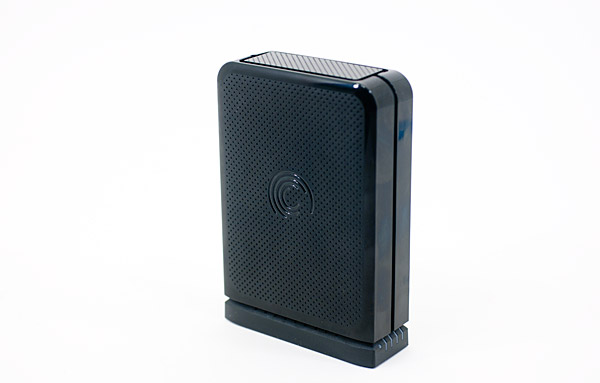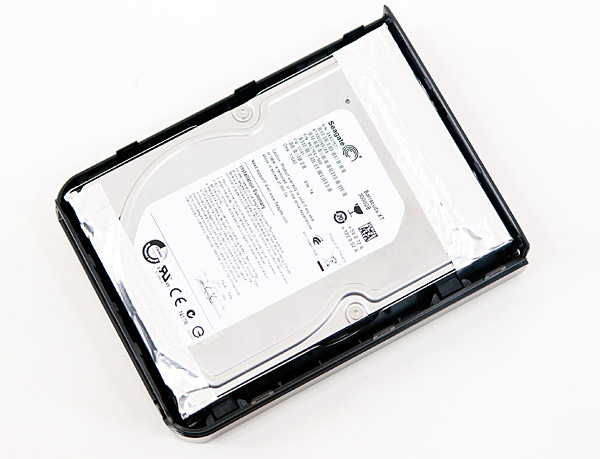The World's First 3TB HDD: Seagate GoFlex Desk 3TB Review
by Anand Lal Shimpi on August 23, 2010 12:39 AM EST- Posted in
- Storage
- Seagate
- HDDs
- GoFlex Desk
I’ve spent so much of the past two years covering SSDs that you’d think I’d forgotten about traditional hard drives. All of my work machines have transitioned to SSDs, as have all of my testbeds for reliability and benchmark repeatability reasons I’ve mentioned before. What I don’t mention that often is the stack of 1TB hard drives I use to store all of my personal music/pictures/movies, AnandTech benchmark files that drive my lab and to power my home theater (yes, final update on that coming soon). Hard drives haven’t lost their importance in my mind, their role has simply shifted.
My OS, applications, page file, documents and even frequently played games (ahem, Starcraft 2) all end up on my SSD. That doesn’t leave a lot of room for anything else, and for that bulk data there’s no cheaper or better alternative than mechanical storage.
One and two terabyte drives are now commonplace, the former selling for $60 a pop. Recently Seagate announced the next logical step, a five platter three terabyte drive with a catch - it’s external only.
The FreeAgent GoFlex Desk is a mouthful of branding that refers to Seagate’s line of external 3.5” drives. The drives themselves are standard 3.5” hard drives in a plastic enclosure designed to mate with GoFlex Desk adapters that add USB 2.0, USB 3.0, FireWire 800 or Ethernet connectivity to the drive.

Currently the GoFlex Desk is available in 1TB, 2TB and 3TB capacities. We’ve spent much of the past week testing the latter both as a look at 3TB hard drives as well as the external device itself.
Not Just Another Upgrade
The first thing I did with the GoFlex Desk was try to get access to the drive inside. Despite the fact that Seagate is shipping a 3TB GoFlex Desk, the internal drive (also made by Seagate) won’t be available until the end of the year. That’s silly, I thought, so I went about pulling the drive out of its casing.
The drive part of the GoFlex Desk is little more than two pieces of plastic snapped together. Start to separate them and pull as firmly (yet carefully) as you can and they’ll pop off, hopefully without breaking any tabs in the process so you can snap it back together.

Inside the GoFlex Desk 3TB was a standard 3.5” Seagate Barracuda XT drive. There are rubber squares installed where the mounting screwholes are and the drive is in a metal tray, but other than that this is a run of the mill SATA HDD.


The 3TB Barracuda XT is a 7200RPM drive. The drive has a 32MB DRAM cache, which is half of what Seagate ships on its 2TB drive making it clear that the 3TB drive used in the GoFlex Desk isn’t 100% performance optimized. Seagate reaches its 3TB capacity by using five 600GB platters.
Internally the drive uses 4K sectors however it translates to 512-byte sectors before it reaches the SATA port. This means to a SATA interface the 3TB drive looks like a drive with 512-byte sectors. The GoFlex Desk docks then map the 512-byte sectors back to the 4K format. There’s obviously overhead associated with these translations but it’s not huge in most cases. The final 4K translation done by the GoFlex Desk dock means that you can partition the drive using MBR which ensures Windows XP compatibility.
Update: Seagate offered some clarification to the paragraph above. Internally the 3TB drive uses 512-byte sectors, however the GoFlex dock emulates a 4K drive to allow for a single 3TB partition to be created in Windows.
For those of you looking to buy a 3TB GoFlex Desk, crack the case open and use the drive inside your system there are some challenges that you should be aware of.










81 Comments
View All Comments
gigahertz20 - Monday, August 23, 2010 - link
The heat problem mentioned in this article makes me wonder why engineers fail to correct issues like these. It can't be that much more expensive to put a fan in the unit along with more ventilation. If it was me, I would have installed a fan inside the enclosure that would only turn on when the unit reaches a certain temperature. That way it still stays quiet, but when it gets heated up to the point where it can affect its life span, the fan will cool it down.MarkLuvsCS - Monday, August 23, 2010 - link
lol so first they have a bit of an issue with some firmware and such, but now they decide their 3TB drives should double as coffee warmers?!?!?I used to consider Seagate pretty good mfg but honestly ever since their 1TB fiasco days I don't even consider them. I certainly don't want to see less competitors out there but they really need to get their acts in order.
siuol11 - Monday, August 23, 2010 - link
I used to use Seagate exclusively... I had a RAID 0 array of 7200.10 320's, and one failed completely, erasing most of my papers and photos I'd saved from college. I also had a 500GB 7200.11, one of the few to not suffer from the .11's random fail bug- 5 months in to using it, the SATA connector snapped off (there was nothing putting pressure on it, it just snapped. I booted up my computer one morning and it couldn't find the drive). My last Seagate was a 1TB 7200.12, which started getting massive amounts of bad clusters 10 months in to using it. Thankfully it lasted long enough for me to transfer my files.Since then I've switched to Maxtor... I know you can't really use the retail drives in RAID arrays, but at least none of them have blown up on me.
Belard - Monday, August 23, 2010 - link
RAID-0 is pretty much pointless... And are more acceptable to failures.If your data was that important, then a backup drive should have been used, ESPECIALLY with a RAID-0 setup.
- MAXTOR is owned by Seagate and both "brands" come off the same assembly lines... Never heard of "Can't raid a retail drive" before. Most OEMs are single drive setups... a drive is a drive.
xded - Monday, August 23, 2010 - link
> Never heard of "Can't raid a retail drive" before. Most OEMs are single drive setups... a drive is a drive.Not entirely true. The problem is that, in case of errors, the firmware on retail drives will keep trying reading the faulty sector for too long. This delay will make the RAID controller assume that the drive is gone and it will drop it out of the chain. This unnecessarily increases the load on the array due to the subsequent rebuild phase. If then another drive should fail under the increased load, you will most likely lose the whole array, while correcting the unreadable sector in the first place would have been trivial.
This is why most manufacturers also sell "RAID edition" HDDs which, other than a tweaked firmware, also have a considerably higher MTBF.
For further information, see here http://en.wikipedia.org/wiki/Time-Limited_Error_Re...
see
Belard - Monday, August 23, 2010 - link
Oh... okay. I've not forgotten about enterprise class drives, for a REAL RAID setup, I wouldn't use consumer grade drives.But for most home users, using off the shelf is usually fine. But still RAID-0 is useless compared to the speed to todays drives. The complexity, the overheard and errors aren't worth it.
Want to improve BOOT up time and startup of your apps, spend $150~$200 for an SSD.
pcfxer - Tuesday, August 24, 2010 - link
Complexity? You must be retarded.You can geom Mirror, ZFS RAID-Z, HFS+ RAID or use the onboard software RAID.
If you know what you are doing RAID is fine, but thinking RAID will improve game load speeds is lol-eriffic.
siuol11 - Monday, October 11, 2010 - link
Man, I had completely forgotten about this comment till I came back to this thread today. Thanks for the comments guys, I'm aware of all of this. The 2 .10's in RAID 0 were 320's that I was using as data drives, I'm aware that RAID 0 on physical disks doesn't help latency.I'm fairly sure Maxtor ans Seagate have different QC mechanisms, which make all the difference in the world... And after failures of 3 successive generations of their drives, I think I'll pass. I'm still pissed that I lost all that stuff (and yes, yes, I know I should have had a backup. It just wasn't possible at that time).
Wolfpup - Thursday, September 16, 2010 - link
Yikes, this gives me yet MORE reason to avoid "RAID" 0.adamdz - Monday, August 23, 2010 - link
But you had a backup, right? So you were able to get all your papers and photos back, right?And, yeah Maxtor is owned by Seagate and it was always garbage.